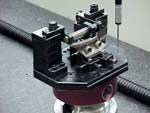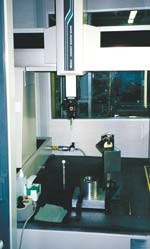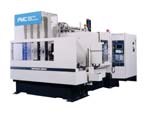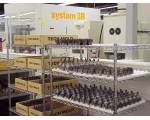Harnessing The Quality Engine
Honeywell’s Phoenix aerospace plant uses a dedicated CMM to ensure quality and reduce costs in a high-volume manufacturing cell.
Share







.png;maxWidth=45)
DMG MORI - Cincinnati
Featured Content
View More




Autodesk, Inc.
Featured Content
View MoreDuring the heart-pounding seconds after an airline pilot guns his engines for takeoff, passengers are hushed by the extraordinary thrust that sends the jet hurtling down the runway. The modern jet engine is a technological marvel that generates its thunderous power by burning a mixture of compressed air and gas, then expelling this superheated stream through a relatively small nozzle outlet. As the engine’s basic operating principle illustrates, bottlenecks don’t necessarily represent obstacles to performance. Indeed, the point at which a process is most tightly constrained can sometimes hold the greatest potential for progress.
Travelers at Sky Harbor International Airport in Phoenix can’t miss the huge Honeywell building that abuts the runway area. This property covers approximately 1 square mile and houses 604,000 square feet of manufacturing and assembly space. This facility is the headquarters of Honeywell Engines, Systems and Services, part of Honeywell Aerospace, a leading worldwide manufacturer of engines, integrated avionics, systems and service solutions. This division of the firm is the world’s largest producer of small gas turbine engines used for auxiliary power on commercial jets and for main propulsion on business jets. The firm’s aerospace business earned sales of $10.5 billion last year, producing a variety of aircraft components for customers around the globe.
A Matter Of Thrust
The powerful thrust that propels a jet airliner is generated within a relatively small area inside each engine. When hot gas exits from the engine’s combustor, vanes in a ring-shaped part known as the “turbine nozzle assembly” direct it into the turbine rotors. In the process, this stream accelerates dramatically as it passes through small vane openings and relinquishes heat and pressure. The resulting high-velocity exhaust powers the gas turbine engine that is the source of the aircraft’s motive power.
The circular turbine nozzle assembly is composed of 11 to 17 turbine nozzle segments. These segments are carefully machined and matched during assembly to achieve optimum aerodynamic performance. Because the parts must withstand red-hot temperatures during engine operation, they are machined from nickel and cobalt-based superalloys.
Although some turbine nozzle segments have been produced by outside vendors, the company estimated that it would save substantial expense and improve quality by bringing this production in house. The plant’s current production of these new segments began in March 2001.
Lower Costs And Higher Efficiency
Because a typical nozzle segment incorporates 30 key features that require inspection, the cost of inspecting every feature with conventional gages would have been excessive. “Our decision to use a designated CMM for this manufacturing cell was not based on reducing the time necessary to perform the inspection work itself,” says James Rebenar, Honeywell’s CMM programmer. “But without the CMM, a separate hard gage would be necessary to inspect each operation. At a cost of $10,000-$25,000 per gage, it was more sensible to purchase a dedicated, shopfloor CMM rather than to create hard gaging.” This is particularly true because any future changes in part specifications would require modifying or purchasing additional hard gages.
Another factor that weighed heavily in Honeywell’s decision was the need to avoid queuing these parts with other parts awaiting inspection by CMMs the plant uses for general part-layout purposes. Because Honeywell produces approximately 20,000 nozzle segments per year, not having a dedicated CMM for this particular cell would drastically increase lead time and expense per part.
Honeywell addressed these needs by installing a Bright Apex 707 CMM manufactured by Mitutoyo America Corporation (Aurora, Illinois) in its production cell. This CMM incorporates real-time, automatic temperature compensation that employs a sensor in each axis, as well as two sensors that monitor the workpiece temperature. Equipped with a high-precision probe head manufactured by Renishaw Inc. (Schaumburg, Illinois), the CMM has a working range of 27.75 inches in both the X and Y axes, and 23.81 inches in the Z axis. The workpiece weight capacity is 1,102 pounds. The CMM currently inspects every feature on every part manufactured by this machine.
According to Mr. Rebenar, the maximum time necessary for the CMM to inspect the most complex of these nozzle segments is approximately 8 minutes. Each of four fixtures used to hold the parts is color-coded to eliminate errors, and the CMM verifies the required inspection routine by probing the inside diameter of a circular bushing at the base of each fixture. This dimension corresponds to the specific part and operation, as well as to its required inspection routine. Having an automated CMM on the shop floor provides the important advantage of freeing the operator to perform other tasks while the inspection routine is running.
The Single-Machine Strategy
The heart of Honeywell’s production cell for the nozzle segments is a multi-process machining center manufactured by Hitachi Seiki USA, Inc. (Itasca, Illinois). The horizontal, five-axis HS500 machining center performs all grinding and machining required to produce these parts in four operations. The machine also incorporates a vertical workpiece changer that enables the operator to merely load the fixtured castings then retrieve the parts after machining.
Compared to the process that would be required to produce this type of part with conventional machines, Honeywell garners substantial savings with its multi-process machine. The labor of at least five people would be necessary to produce these parts using multiple drill presses and grinding machines. With the multi-process machine, however, Honeywell needs only one operator, and no manual machine setups are necessary. “The new equipment has significantly reduced both the production cost for these parts and our lead time,” says Honeywell’s project manager Chip Svoboda.
Although Honeywell currently deburrs the nozzle segment parts manually—presently representing a considerable amount of time in the overall production process—the company is developing plans to equip the Hitachi Seiki machining centers with special deburr brushes to automate this task.
In-Process Analysis
The capabilities of the CMM and its controlling software have helped Honeywell move beyond the paradigm of quality control as a post-mortem examination. “Now we have much more information about the machining process,” says Mr. Svoboda. “In the past, we didn’t have this data—just the operator’s comment that a particular part was good or bad.”
Because a primary goal of any manufacturing process is to reduce variations, Honeywell has met this challenge by initiating a comprehensive quality strategy known as Six Sigma Plus. Defined strictly in numerical terms, this standard establishes the goal of achieving fewer than 3.4 defects per million opportunities. But from a broader perspective, this target assumes the implementation of a company-wide strategy that predicates the firm’s future growth on the continuous improvement of every product and service.
It’s a well-known metalworking principle that the number and severity of variations in mass-produced parts will increase gradually as the result of advancing tool wear. The CMM enables Honeywell to rapidly measure each finished part and to combine the measurements of many parts within a historical database. This data enables Honeywell to better control its machining process.
In particular, the company can predict tool consumption rates more accurately and standardize its tool change intervals. For example, four separate grinding operations are necessary to finish the surfaces of Honeywell’s nozzle segments. By examining tolerance drift on charts generated by the CMM software as production continues, replacement intervals for CBN grinding wheels can be established according to actual grinding conditions. This improves wheel utilization by eliminating reliance on rule-of-thumb estimates that may not reflect certain variables in a particular grinding operation.
Because they were accustomed to measuring with hard gages, Honeywell’s operators found that the CMM’s greater accuracy demands more attention to process parameters. “Our inspection process does not allow any out-of-tolerance features, so we have initially spent a considerable amount of time chasing errors in the range of 0.0001 inch,” says Mr. Svoboda. “The CMM forces us to go back and examine our manufacturing process in much more detail.”
Although this might seem troublesome from a conventional perspective, more intensive data analysis enables manufacturers to better understand their production processes. It also helps to develop and refine effective statistical process control (SPC) systems. To this end, the Mitutoyo CMM’s software generates graphical reports that illustrate the distribution and trends of process variations. The long-term savings that accrue from using these tools to maintain a more accurate process far outstrip the additional time spent performing analytic work.
Because its software incorporates the Dimensional Measuring Interface Standard (DMIS), the CMM has the capacity to interchange data with other measuring devices without the need for translation. An additional module can be added to this software package that enables CAD data to be read directly from AutoCAD. Thus, the measurement and quality system may be networked throughout the plant, providing office personnel with the same real-time access to process data that is available to operators on the shop floor. “We’ve found that the CMM software is relatively simple to use, and we haven’t experienced any problems in our programming work,” says Mr. Rebenar.
With the company’s new approach to machining and inspecting these flight-critical parts, the speed of Honeywell’s manufacturing process has received a substantial boost. Despite the growing demand for these products, Honeywell now has the ability to provide much faster response to its customers while further improving quality. By using its measurement capability to identify in-process quality trends and applying this information to fine-tune the manufacturing process, Honeywell has tapped a new source of power to drive its future growth.
Related Content
How to Accelerate Robotic Deburring & Automated Material Removal
Pairing automation with air-driven motors that push cutting tool speeds up to 65,000 RPM with no duty cycle can dramatically improve throughput and improve finishing.
Read MoreManaging Coolant with Skimmers, Refractometers and More
Bacteria-infected coolant harms machines and sickens machinists. Coolant management technologies like skimmers and automated systems counter this tendency.
Read MoreCNC Machine Shop Honored for Automation, Machine Monitoring
From cobots to machine monitoring, this Top Shop honoree shows that machining technology is about more than the machine tool.
Read MoreUsing the Toolchanger to Automate Production
Taking advantage of a feature that’s already on the machine tool, Lang’s Haubex system uses the toolchanger to move and store parts, making it an easy-to-use and cost-effective automation solution.
Read MoreRead Next
Sizing Up The Future
This shop installed a bigger CMM to meet its current needs, but the software that came with it has the shop ready for what lies ahead.
Read MorePutting Measurement In The Loop
A precision moldmaker aims to boost production and quality by automating metrology.
Read MoreBuilding Out a Foundation for Student Machinists
Autodesk and Haas have teamed up to produce an introductory course for students that covers the basics of CAD, CAM and CNC while providing them with a portfolio part.
Read More


















.png;maxWidth=150)

















.jpg;maxWidth=300;quality=90)




.jpg;maxWidth=300;quality=90)











